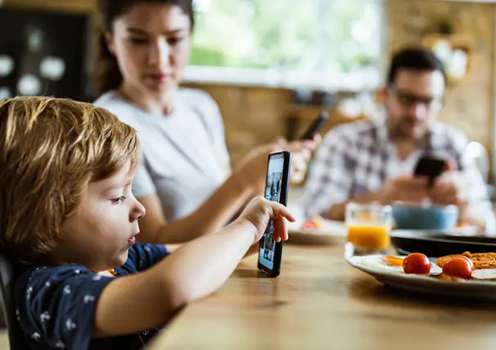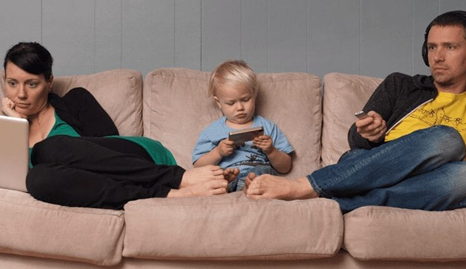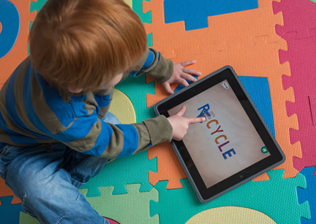Technology and the Developing Mind: Striking the Right Balance
By: Diya Jaiswal, B.Sc. Neuroscience
Picture this: You’re at a restaurant, and a toddler at the next table is glued to an iPad, completely zoned out. Across from them, their parent is scrolling through emails, barely noticing their surroundings. Sound familiar? In today’s world, technology is everywhere smartphones, tablets, laptops, and even smart TVs that can stream endless content. Screens have become a go-to for entertainment, education, and even parenting.
But is this constant exposure helping or harming our kids?
The Great Tech Debate: Friend or Foe?
There’s no denying that technology has transformed the way we live. It keeps us connected, provides endless learning opportunities, and, let’s be honest, gives parents a much-needed break when needed. But just like too much sugar can lead to cavities, excessive screen time can have lasting effects on a child’s development.
Dr. Laura Markham, a child psychologist, explains that “young children’s brains develop through interactions with caregivers, not screens.” The Harvard Center on the Developing Child (2020) supports this, emphasizing the importance of serve-and-return interactions those back-and-forth exchanges between a child and an engaged adult. When a baby coos and a caregiver responds, that simple moment strengthens neural pathways. However, if a child spends more time interacting with a tablet than a person, these essential brain-building moments decrease.
The “iPad Baby” Phenomenon: What’s Really Happening?
Ever heard the term “iPad baby”? It refers to toddlers who are so used to digital entertainment that they struggle with real-world interactions. Studies show that excessive screen time, particularly before age two, can delay language development. The American Academy of Pediatrics (AAP) found that toddlers who spend more than two hours a day on screens may have lower verbal and cognitive skills compared to their peers who engage in more face-to-face interactions (Council on Communications and Media, 2016). Parents often notice this in small ways kids struggling to maintain eye contact, having shorter attention spans, or becoming frustrated when a real book doesn’t “swipe” like an e-book.
Parental technology use also plays a role in child development. When parents are frequently on their phones, children receive fewer social interactions, which can impact attachment and emotional development. Studies show that "technoference"—parental distraction by digital devices can lead to increased behavioral issues in children (McDaniel & Radesky, 2018).
The Hidden Impact on Speech & Attention
One of the biggest concerns with too much screen time is its impact on phonetic learning. Language development isn’t just about hearing words it’s about hearing them in real time from a real person. When kids watch a show, they aren’t getting the personalized responses that help them fine-tune their understanding of speech sounds. Researchers at Common Sense Media (Rideout & Robb, 2020) found that children learn best from live interaction, where they can see facial expressions, hear tone changes, and receive immediate feedback.
Screens can also impact attention spans. Platforms like YouTube Shorts and TikTok serve fast, flashy content that conditions young brains to crave constant stimulation. As a result, focusing on slower-paced activities like reading a book or even engaging in conversation becomes more challenging.
The Upside: How Screens Can Help
But before we throw tablets out the window, let’s acknowledge that technology isn’t all bad. In fact, when used wisely, it can be an incredible tool for learning and development. Interactive apps like ABCmouse and Khan Academy Kids encourage cognitive growth, literacy, and problem-solving abilities (Hutton et al., 2020). Assistive technology has transformed education and communication for children with disabilities. Speech-to-text applications, sensory-friendly learning programs, and adaptive devices provide meaningful support for children with autism, ADHD, and other developmental challenges (Zwaigenbaum et al., 2021).
When used wisely, technology can be a helpful tool in a balanced parenting approach. Digital devices can be lifesavers for parents desperately needing a moment of rest. A short educational video or an interactive game can provide children with entertainment while parents complete tasks or take a break (Madigan et al., 2019). Technology helps families stay connected, particularly when living apart. Video calls allow grandparents to engage with their grandchildren, and messaging apps make it easier for busy parents to check in with their kids (Radesky et al., 2020). For older children, social media and digital platforms provide avenues for socialization and maintaining friendships.
So, what’s the key? Mindful tech use! Instead of passive screen time (endless scrolling or background TV), opt for interactive engagement. Co-viewing educational content with your child, asking questions, and encouraging discussion turn screen time into a social, learning-rich experience and reinforcing real-world connections.
Creating a Tech-Healthy Home
So how do we embrace technology without letting it take over? Here are some simple, research-backed ways to set healthy boundaries:
● Tech-Free Zones & Times - Establish screen-free moments like mealtime and bedtime. Studies show that blue light from screens disrupts sleep, so shutting off devices at least an hour before bed helps kids (and adults!) sleep better (WHO, 2019)
● Set Screen Time Boundaries- Set healthy boundaries with technology, the American Academy of Pediatrics (AAP) recommends:
○ Avoid screens for children under 18 months (except for video calls)
○ Limit screen time to one hour per day for children ages 2–5, focusing on high-quality content.
○ Encourage structured screen use with educational value for older children (AAP, 2016).
● Prioritize Conversation & Play - No app can replace the benefits of a good chat. Whether it’s storytelling, playing pretend, or just talking about the day, these moments strengthen a child’s cognitive and emotional development.
● Swap Screens for Real-Life Engagement -Instead of watching a nature documentary, take a trip to the Helen Schuler Nature Reserve in Lethbridge and explore wildlife in person. Hands-on experiences deepen learning and create lasting memories.
● Model Healthy Tech Use -Kids mimic what they see. If they see parents glued to their phones, they’ll do the same. Try putting your device away during family time and encourage face-to-face interaction instead.
Local Resources for Lethbridge Families
Looking for ways to engage your child beyond the screen? Check out these amazing community programs:
● Building Brains Together - We have so many resources on this website for parents and caregivers on healthy brain development. Check out our resources page for fun games that foster play-based learning!
● Lethbridge Public Library - Interactive storytimes help kids develop a love for reading, a fun way to encourage early literacy while engaging with others! www.lethlib.ca
● City of Lethbridge Recreation Programs - From swimming lessons to sports programs, these activities help kids develop physical and social skills while taking a break from screens! www.lethbridge.ca/recreation https://www.lethbridgeplays.ca/events
It’s All About Balance!
At the end of the day, technology is neither all good nor all bad, it’s how we use it that matters. By being mindful of screen time, prioritizing face-to-face interactions, and incorporating hands-on learning, families can enjoy the benefits of technology without letting it interfere with healthy development. A little mindfulness goes a long way in helping kids grow, learn, and connect in the real world!
References
American Academy of Pediatrics. (2016). Media and young minds. Pediatrics, 138(5), e20162591. https://doi.org/10.1542/peds.2016-2591
Center on the Developing Child. (2020). Serve and return: How interaction shapes brain architecture. Harvard University. https://developingchild.harvard.edu/
Hale, L., & Guan, S. (2015). Screen time and sleep among school-aged children and adolescents: A systematic literature review. Sleep Health, 1(2), 50–58. https://doi.org/10.1016/j.jos.2014.06.008
Hutton, J. S., Dudley, J., Horowitz-Kraus, T., DeWitt, T., & Holland, S. K. (2020). Associations between screen-based media use and brain white matter integrity in preschool-aged children. JAMA Pediatrics, 174(1), e193869. https://doi.org/10.1001/jamapediatrics.2019.3869
Kirkorian, H. L., Pempek, T. A., Murphy, L. A., Schmidt, M. E., & Anderson, D. R. (2016). The impact of background television on parent-child interaction. Human Communication Research, 34(4), 375–395. https://doi.org/10.1111/j.1468-2958.2008.00326.x
Madigan, S., Browne, D., Racine, N., Mori, C., & Tough, S. (2019). Association between screen time and children’s performance on a developmental screening test. JAMA Pediatrics, 173(3), 244–250. https://doi.org/10.1001/jamapediatrics.2018.5056
McDaniel, B. T., & Radesky, J. S. (2018). Technoference: Parent distraction with technology and associations with child behavior problems. Child Development, 89(1), 100–109. https://doi.org/10.1111/cdev.12822
Zwaigenbaum, L., Bauman, M. L., Choueiri, R., et al. (2021). Early intervention for children with autism spectrum disorder under 3 years of age: Recommendations for practice and research. Pediatrics, 138(6), e20161889. https://doi.org/10.1542/peds.2016-1889







